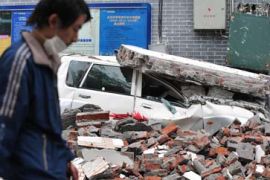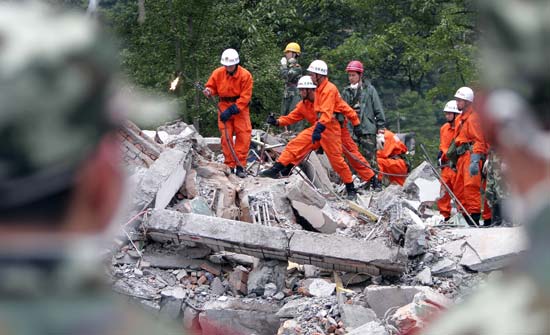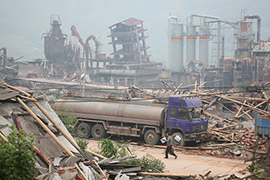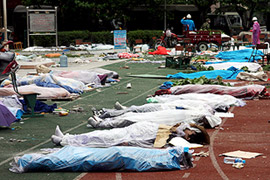Hopes fade in quake-hit Sichuan
State TV estimate comes amid fading hopes for tens of thousands buried under rubble.

 |
| Tens of thousands of people remain unaccounted for [AFP] |
Hopes of finding more survivors are fading three days after a deadly earthquake flattened cities and towns in southwestern China.
| In depth: China quake |
|
Map: Quake disaster zone China’s fast response |
The Chinese authorities said on Thursday that, in all likelihood, 50,000 people had already perished.
Tens of thousands of people are thought to still be buried under the rubble, following Monday’s 7.9-magnitude quake in Sichuan province.
At least 7,700 people were feared dead in the town of Yingxiu alone, while in Shifang an estimated 30,000 people were missing or out of contact, local officials told Xinhua news agency.
Xinhua said three mountainous towns north of the provincial capital of Chengdu were still cut off, and that 20,000 residents remained buried in rubble in the towns of Qingping, Jinhua and Tianchi.
Zhang Zhoushu, vice-director of the state-run China Earthquake Disaster Prevention Centre, said: “If there are some survivors under such conditions, it would be a matter of luck or a miracle.”
Citing relief figures from the national quake relief headquarters, sate television reported: “The deaths are estimated to be over 50,000.”
Greater support
In a fresh push to find survivors, the government ordered additional troops and helicopters to reinforce search-and-rescue operation across the disaster zone where more than 10 million people are thought to be directly affected.
| IN VIDEO | ||
|
The military also announced plans for the first large-scale air drop of 50,000 food packets and tens of thousands of blankets and clothing items.
The government said it had set aside $159m for the disaster, while public donations have totalled $125m so far in cash and kind.
Wen Jiabao, the Chinese premier, was quoted as telling a meeting of disaster response officials late on Wednesday that “we must use all our forces and save lives at whatever cost”.
Japan rescue team
And the Communist party leadership told local officials to “ensure social stability” amid rumours of chemical spills, fears that dams could burst and torrid scenes of collective grief.
 |
| A damaged chemical plant and dam threatens to cause bigger problems [GALLO/GETTY] |
There was also a growing concern over water and sanitation – as temporary toilets failed to keep up with demand – and building safety, especially of school buildings in the region.
On Thursday, Beijing accepted Japan‘s offer to send in emergency rescue teams, the first country from which it has accepted such help.
“China‘s government has agreed with Japan on the sending of special rescue personnel to the Sichuan earthquake disaster zone to aid relief efforts,” Qin Gang, a foreign ministry spokesman, said in a statement.
It has accepted volunteers and relief goods from Taiwan, but from a non-governmental Buddhist group.
Australia and South Korea said Beijing had rejected their offers of help.
Call for equipment
The authorities also made a public plea through state media for equipment ranging from hammers, shovels and demolition tools to cranes and rubber boats to help in recovery efforts.
 |
| Bodies are piling up in the disaster zone faster than they can be buried [EPA] |
State television showed disaster relief teams digging through the rubble of demolished buildings with their bare hands in search of survivors.
Heavy rains and a possible threat from a damaged dam near Dujiangyan, less than 50km from the quake’s epicentre, continued to hamper relief efforts.
State media also reported that aftershocks continued to shake the region on Thursday, triggering fresh landslides and causing buildings to collapse, further weakening already damaged structures, although there was no word on further casualties.
More than 1,000 aftershocks have been recorded in the Sichuan region since Monday’s earthquake – one of the deadliest in China‘s history and the worst since the 1976 quake in the northern city of Tangshan that killed more than 240,000 people.

